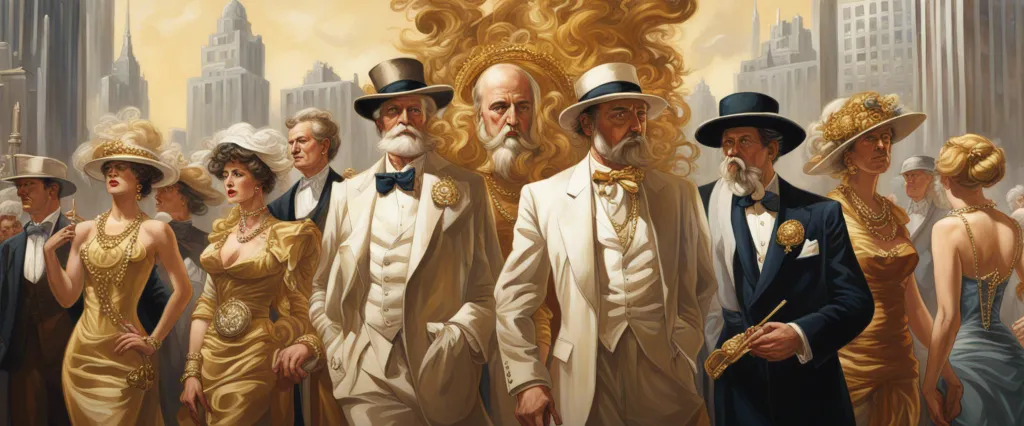The Age of Gold by H. W. Brands is a captivating historical account that delves into the dramatic events of the California Gold Rush in the mid-19th century. In this remarkable narrative, Brands skillfully explores the captivating tales of struggle, ambition, and determination that shaped this pivotal era in American history. A renowned historian, H. W. Brands has authored numerous bestselling books, including “The First American” and “Traitor to His Class,” earning him recognition as a master storyteller and an expert on American history. Through his meticulous research and engaging prose, Brands offers readers a vivid and unforgettable journey into the heart of the tumultuous Age of Gold.
Chapter 1: The Discovery of Gold
Chapter 1 of the book “The Age of Gold” by H. W. Brands, titled “The Discovery of Gold,” discusses the events surrounding the discovery of gold in California in the mid-19th century. Brands begins by shedding light on the circumstances that led to tens of thousands of individuals migrating to California, dreaming of finding fortunes in gold.
In January 1848, gold was discovered by James Marshall at Sutter’s Mill, in present-day Coloma, California. Brands highlights Marshall’s initial impression of the gold and his efforts to keep the discovery a secret, fearing an influx of prospectors would disrupt his employer’s plans of establishing a sawmill. However, news of the gold eventually leaked, and the ensuing excitement triggered the California Gold Rush.
Brands describes the immediate impacts of the gold discovery, detailing how the news spread slowly at first but then rapidly reached people across America, inflaming their temptations for wealth. Men from all walks of life, including farmers, ex-soldiers, and even intellectuals, abandoned their families, jobs, and responsibilities, setting out for California. As they made their way west, they faced numerous perils, from hostile Native American tribes to treacherous landscapes and scarce resources.
The author emphasizes the indiscriminate nature of gold fever, which affected people regardless of their social status or background. He shares stories of individuals who left behind successful careers or stable lives in search of fortune, driven by tales of unimaginable wealth. Brands highlights how the discovery of gold not only disrupted the lives of individuals but also transformed society, as communities were emptied and entire industries were put on hold.
Overall, Chapter 1 of “The Age of Gold” serves as an introduction to the frenzy that the discovery of gold in California instigated, setting the stage for the transformative events that would unfold during the subsequent years of the California Gold Rush.
Chapter 2: The Rush Begins
Chapter 2: The Rush Begins of the book “The Age of Gold” by H. W. Brands is an exploration of the California Gold Rush and the initial wave of migrants it attracted in the mid-19th century.
The chapter begins by describing the early perceptions and beliefs surrounding the discovery of gold in California. It highlights how rumors and speculation initially surrounded the news, but as more evidence emerged, thousands of men from different backgrounds and regions flocked to California in search of their fortune.
Brands introduces several key characters throughout the chapter, illustrating the diverse group of individuals lured by the allure of gold. These include Thomas O. Larkin, a businessman and diplomat who played a significant role in validating the gold discovery, Samuel Brannan, a Mormon merchant who used his newspaper to communicate the news and encourage migration, and James W. Marshall, the man credited with discovering gold at Sutter’s Mill.
The author explains the journey that many prospectors undertook to reach California, including the hazardous paths they navigated, such as crossing the Isthmus of Panama or enduring the treacherous voyage around Cape Horn. The chapter emphasizes the risks and hardships associated with these journeys, which proved fatal for some and financially ruinous for others.
Once in California, Brands explores the emergence of mining camps and the social and economic dynamics within them. He portrays the competition, lawlessness, and ethnic tensions that arose as people staked their claims and established communities. The chapter also delves into the vast profits and losses experienced by prospectors, highlighting the pivotal role that luck played in finding significant amounts of gold.
Overall, Chapter 2 provides a gripping overview of the initial wave of migrants and the various challenges they faced during the early stages of the California Gold Rush.
Chapter 3: The Mining Life
Chapter 3: The Mining Life, from the book “The Age of Gold” by H. W. Brands, explores the experiences and challenges faced by the prospectors during the California Gold Rush of the mid-1800s. The chapter delves into the miners’ daily lives, labor, and the overall culture that characterized this intense period of gold rush fever.
Brands highlights the allure of gold and the hopes it kindled in the hearts of thousands of people who flocked to California. The chapter begins by describing the arduous journey endured by these men as they traveled vast distances in search of their fortune. Upon arriving at the mining regions, miners faced immense difficulties. They had to adapt to harsh climate conditions, fighting against freezing winters and scorching summers, often with limited resources.
Furthermore, Brands emphasizes the grueling physical labor of mining and the need for teamwork and cooperation among miners. While some miners worked independently, others formed partnerships or joined larger mining companies. The chapter reveals the communal aspects of mining camps that emerged as miners relied on each other for protection, food, and supplies.
The book also addresses the drastic changes brought about by the sudden population increase, leading to conflicts over land ownership and water rights. Brands captures the tension that arose as more miners arrived, resulting in a competitive and cutthroat environment. This led to the introduction of a mining code, establishing rules and regulations to regulate disputes and provide some level of order.
In summary, Chapter 3 of “The Age of Gold” explores the experiences and challenges faced by miners during the California Gold Rush. It sheds light on the harsh conditions, physical labor, and the emergence of a unique mining culture characterized by cooperation and competition. Brands paints a vivid picture of the mining life, capturing the essence of this historic period in American history.
Chapter 4: Boomtowns and Lawlessness

In Chapter 4 of “The Age of Gold” by H. W. Brands, titled “Boomtowns and Lawlessness,” the author delves into the chaotic nature of the gold rush era and its impact on the development of towns and communities in California during the mid-1800s.
Brands highlights the rapid growth of settlements as gold prospectors flocked to the region, transforming remote areas into vibrant boomtowns almost overnight. These towns lacked any established systems or infrastructure, causing lawlessness to prevail. Vigilante justice often took the place of formal legal institutions, with citizens forming vigilance committees to maintain order and discourage criminal activities.
The author introduces the lawless towns of San Francisco and Sacramento, which became notorious for their rampant violence, gambling, prostitution, and lack of effective law enforcement. Criminals realized the opportunity to exploit the disorder, resulting in robberies, stagecoach hold-ups, and numerous violent crimes. Brands also explores the role of statewide vigilante committees, such as the San Francisco Committee of Vigilance, which sought to restore order and stability to the region.
Amid the chaos and lawlessness, some individuals saw an opportunity to profit and establish legitimate businesses. Entrepreneurs and ambitious individuals opened saloons, hotels, and other establishments to cater to the booming population. However, these businesses often faced challenges due to the high prices, limited supplies, and the unpredictable nature of the gold rush.
Overall, Chapter 4 of “The Age of Gold” depicts the unrestrained and turbulent atmosphere of the boomtowns. It showcases the struggles, opportunities, and the varying degrees of lawlessness that emerged as California experienced a transformative and tumultuous period during the gold rush.
Chapter 5: Economic and Social Transformations
Chapter 5: Economic and Social Transformations of the book “The Age of Gold” by H.W. Brands delves into the profound societal changes brought about by the California gold rush in the mid-19th century. The chapter provides a comprehensive overview of the economic and social implications of the gold rush, exploring how it transformed the lives of individuals, communities, and the nation as a whole.
Brands highlights how the gold rush attracted an incredibly diverse group of people from all over the world, creating a melting pot of cultures, languages, and backgrounds. The sudden influx of immigrants, commonly referred to as “forty-niners,” significantly impacted the demographics and social fabric of California. These migrants arrived in pursuit of wealth and opportunity, contributing to the rapid growth and development of towns and cities across the region.
Economically, the gold rush had a profound impact on both individuals and the wider American economy. Brands explains how the discovery of gold allowed many ordinary Americans to achieve previously unimaginable wealth, leading to a substantial increase in economic mobility. Additionally, the increased economic activity stimulated by the gold rush had a ripple effect on other industries such as agriculture, trade, and transportation, helping to fuel the overall growth of the United States.
However, the gold rush also had its dark side. Brands discusses the challenges and harsh realities faced by those who ventured to California, including the grueling labor, lawlessness, and rampant speculation that characterized this period. He explores the ways in which the pursuit of gold intensified racial tensions, particularly towards Native Americans and the Chinese immigrants who faced discrimination and violence from white settlers.
In summary, Chapter 5 of “The Age of Gold” provides an in-depth analysis of the economic and social transformations brought about by the California gold rush. It reveals how the influx of people seeking fortune impacted both individual lives and the broader nation, shaping the very fabric of American society and leaving a lasting legacy on the United States’ economic growth and cultural landscape.
Chapter 6: The New American Dream
Chapter 6 of “The Age of Gold” by H. W. Brands explores the concept of the New American Dream, which emerged in the wake of the California Gold Rush. This chapter delves into the societal and economic changes that occurred during this period, as well as the impact of the Gold Rush on American identity and the pursuit of wealth.
Brands begins by discussing how the discovery of gold in California attracted people from all walks of life, creating a diverse society in the region. The Gold Rush opened up opportunity for ambitious individuals hoping to pursue a better life. It symbolized the possibility of achieving social mobility and economic success. People from all over the United States, as well as immigrants from different parts of the world, flocked to California in search of gold, leading to a dramatic increase in population.
As the Gold Rush gained momentum, Americans became fixated on the idea of sudden wealth and material prosperity. The desire to strike it rich became a central part of the American Dream. However, Brands also highlights the harsh reality of the Gold Rush, with many prospectors failing to find significant amounts of gold. Despite this, the idea that anyone could achieve success through hard work and determination became deeply ingrained in American culture.
Moreover, Brands explores the lasting impact of the Gold Rush on American society. While California undoubtedly experienced unprecedented growth, its transforming effects were felt throughout the nation. The pursuit of wealth became a central motif in American society, perpetuating the belief that one could overcome any obstacle through ambition and perseverance.
In conclusion, Chapter 6 delves into the emergence of the New American Dream during the California Gold Rush. Brands analyzes the societal changes brought about by the Gold Rush and the significance of wealth and opportunity in American culture. It highlights the enduring belief in the possibility of achieving success and prosperity, which remains an integral part of the American Dream to this day.
Chapter 7: Environmental Consequences
Chapter 7 of “The Age of Gold” by H. W. Brands focuses on the environmental consequences brought about by the California Gold Rush in the mid-19th century. It details how the pursuit of wealth and the rapid influx of miners into the region led to drastic transformations of the natural landscape and irreparable damage to the ecosystem.
Brands explains that the massive amount of gravel and sediment excavated from rivers and streams during gold mining operations resulted in widespread erosion and the loss of fertile soil. The miners used high-pressure water hoses called “hydraulicking” to wash away mountainsides, causing immense damage to the surrounding vegetation and wildlife habitats. The displacement of such large quantities of earth also wreaked havoc on the waterways, leading to flooding and the redirection of rivers.
Furthermore, the extensive deforestation carried out to meet the demands of the booming population and the mining industry added to the environmental degradation. Massive stands of trees were felled for construction and fuel, resulting in the destruction of vast forests and devastating consequences for local wildlife populations.
The consequences were not limited to land; the gold rush also impacted the marine environment. The intensification of hydraulic mining released vast amounts of sediment into rivers, which eventually made its way to the ocean. This sedimentation severely altered aquatic habitats, causing the decline of fish populations and damaging the livelihoods of local communities dependent on fishing.
Overall, Chapter 7 of “The Age of Gold” illuminates the significant environmental toll exacted by the California Gold Rush. It serves as a reminder of the long-lasting consequences of unchecked human exploitation and efforts to strike it rich at the expense of nature.

Chapter 8: Legacy and Impact
Chapter 8 of “The Age of Gold” by H. W. Brands discusses the legacy and impact of the California Gold Rush. In this chapter, Brands highlights the profound effects that the gold rush had on various aspects of American society and the long-lasting consequences for the individuals involved.
To begin, Brands emphasizes the transformative economic impact of the gold rush. The discovery of gold in California led to a massive influx of people, creating a booming economy as miners, entrepreneurs, and investors flocked to the region. The rush for gold also spurred innovation and development in industries such as transportation, banking, and agriculture. However, Brands also highlights the disparity in wealth distribution, where only a few individuals managed to amass great fortunes while the majority struggled to make ends meet.
Furthermore, Brands explores the lasting impact on the political landscape. The gold rush played a crucial role in California’s path to statehood, as the population explosion led to a push for statehood and a new constitution. Moreover, the gold rush influenced national politics by deepening the divide between the North and the South. The rush increased tensions over the issue of slavery, as thousands of people migrated to California, leading to debates over whether it should be a free or slave state.
In addition to the economic and political consequences, Brands delves into the social and cultural ramifications of the gold rush. The migration of people from different backgrounds, races, and countries reshaped California’s social fabric. The rush also changed Americans’ perception of the West, sparking the ideals of opportunity and progress that would come to define the American dream.
Overall, Chapter 8 of “The Age of Gold” emphasizes the multifaceted impact of the California Gold Rush. It highlights the economic prosperity and the disparities it created, the political influence on statehood and slavery, and the cultural transformation that shaped the American West. Brands demonstrates how this pivotal event left an indelible mark on both local and national history.
After Reading
In conclusion, “The Age of Gold” by H. W. Brands provides a comprehensive and engaging account of the California Gold Rush and its profound impact on America’s history and identity. Through vivid storytelling and thorough research, Brands takes readers on a captivating journey, exploring various aspects of the gold rush including its economic, social, political, and environmental consequences. The author effectively captures the sense of excitement, desperation, and chaos that characterized this era, while also shedding light on the individuals and communities that shaped and were shaped by the gold rush. Overall, “The Age of Gold” offers an insightful and balanced analysis of this transformative period, leaving readers with a deeper understanding of the allure, complexities, and lasting legacy of the California Gold Rush.
1. “Titan: The Life of John D. Rockefeller, Sr.” by Ron Chernow
This biography delves into the life of John D. Rockefeller, the founder of Standard Oil Company. Like “The Age of Gold,” it explores the economic transformation and the rise of American industry during the late 19th century, providing an in-depth analysis of an influential figure during that era.
2. “Empire of the Summer Moon: Quanah Parker and the Rise and Fall of the Comanches, the Most Powerful Indian Tribe in American History” by S.C. Gwynne
This book uncovers the captivating story of the Comanche tribe and its fierce resistance against white settlers in the American Southwest. It highlights the clash between Native American culture and the expanding American frontier, similar to the societal tensions explored in “The Age of Gold.”
3. “The Prize: The Epic Quest for Oil, Money & Power” by Daniel Yergin
“The Prize” is a comprehensive and engrossing history of oil, exploring its impact on politics, economies, and international relations. It captures the essence of gold rush-like fervor surrounding the discovery and exploitation of oil resources, similar to the gold fever that swept through California in “The Age of Gold.”
4. The Great Wave: Price Revolutions and the Rhythm of History” by David Hackett Fischer
In “The Great Wave,” Fischer examines the cycles of inflation and deflation throughout history, particularly focusing on the effects of major price revolutions. This book explores economic upheavals and their societal consequences, much like “The Age of Gold” which analyzes the sudden economic boom and subsequent societal changes caused by the California Gold Rush.
5. “The Battle for Spain: The Spanish Civil War 1936-1939” by Antony Beevor
Beevor’s book offers a detailed and gripping account of the Spanish Civil War, a conflict that deeply impacted Spain and intensified global political tensions. Similar to “The Age of Gold,” this book examines a transformative period in history, exploring the complexities of revolution, ideology, and social change during a specific period.




